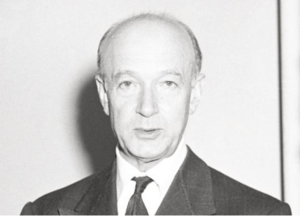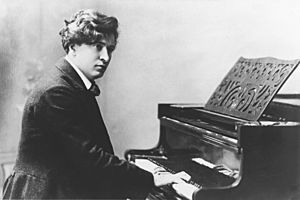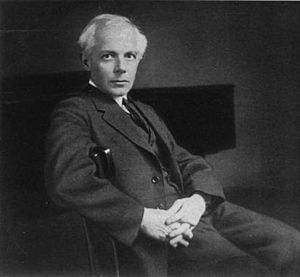Joseph Szigeti facts for kids
Joseph Szigeti (born Szigeti József; September 5, 1892 – February 19, 1973) was a famous Hungarian violin player. He was known for his thoughtful and intellectual approach to music. People even called him "The Scholarly Virtuoso" because he studied music so deeply.
Joseph Szigeti came from a musical family. He showed amazing talent for the violin very early on. He moved to Budapest to study with a well-known teacher named Jenő Hubay. After finishing his studies, Szigeti began his international concert career. At first, he played mostly short, showy pieces. However, after meeting the pianist Ferruccio Busoni, he started to think more deeply about music.
Later, Szigeti became a professor of violin in Geneva, Switzerland, in 1917. There, he met his future wife, Wanda Ostrowska, and became good friends with the composer Béla Bartók. These friendships lasted his whole life. From the 1920s until 1960, Szigeti performed all over the world and made many recordings. He also strongly supported new music. Many composers wrote pieces especially for him, including Ernest Bloch's Violin Concerto and Bartók's Rhapsody No. 1. After he stopped performing in 1960, he taught and wrote until he passed away in 1973 at age 80.
Contents
Joseph Szigeti: A Violin Legend
Early Life and Musical Beginnings
Joseph Szigeti was born in Budapest, Austria-Hungary. His mother died when he was three. He then went to live with his grandparents in a small town called Máramaros-Sziget. This is where his name "Szigeti" comes from. Music was all around him because most of the town band members were his uncles! He had his first violin lessons from his Uncle Bernat when he was six.
Szigeti quickly showed a great gift for the violin. A few years later, his father took him to Budapest for better training. He was accepted into the class of Jenő Hubay at the Franz Liszt Academy of Music without any trouble. Hubay was a top teacher in Europe and a key figure in Hungarian violin playing. Szigeti joined other talented violinists in Hubay's studio.
A Child Prodigy's Journey
Back then, many young musicians became "child prodigies" (meaning they had amazing talent at a young age). Szigeti and his classmates often performed in special concerts while they studied.
In 1905, when he was thirteen, Szigeti performed in Berlin for the first time. He played very difficult pieces by famous composers like Bach, Ernst, and Paganini. Even with such a challenging program, the event was only mentioned with a photo in a newspaper, calling him "A Musical Prodigy."
Szigeti spent the next few months playing short concerts between acts of folk shows. The next year, he even played at a circus in Frankfurt under a different name, "Jóska Szulagi." In 1906, Hubay took Szigeti to meet the famous violinist Joseph Joachim in Berlin. Joachim was impressed and offered to teach Szigeti. However, Szigeti chose to stay with Hubay.
Becoming a Professional Musician
Soon after meeting Joachim, Szigeti went on a big concert tour in England. There, he met a kind couple who invited him to stay with them. He gave many successful concerts across England. He even played the first piece written just for him: Hamilton Harty's Violin Concerto. During this time, Szigeti also toured with famous musicians like singer Dame Nellie Melba and pianists Ferruccio Busoni and Wilhelm Backhaus.
Meeting Important Mentors
The most important person Szigeti met was Busoni. This great pianist and composer became Szigeti's guide during his early career. They remained close friends until Busoni's death in 1924. Szigeti admitted that before meeting Busoni, he was a bit lazy and just played easy, crowd-pleasing songs. He didn't truly understand the deeper meaning of the great masters' music. Busoni helped him change this, especially by studying Bach's Chaconne together. Szigeti said Busoni "shook me once and for all out of my adolescent complacency."
Overcoming Challenges
In 1913, Szigeti got tuberculosis, a lung illness. He had to stop his concerts and go to a special hospital in Davos, Switzerland, to get better. While there, he reconnected with composer Béla Bartók, who was also recovering from an illness. They had known each other briefly before, but now they became lifelong friends. Szigeti's doctor even told him to practice the violin for 25 to 30 minutes a day to help his recovery.
By 1917, Szigeti was fully recovered. At 25, he became a Professor of Violin at the Geneva Conservatory of Music. This teaching job helped him understand music more deeply, including chamber music and music theory. During this time, Szigeti also met and fell in love with Wanda Ostrowska. She was a young woman from Russia who was stuck in Geneva because of the Russian Revolution of 1917. They got married in 1919.
His Career Takes Off
In 1925, Szigeti met the conductor Leopold Stokowski. Szigeti played Bach's Chaconne in D minor for him. Less than two weeks later, Szigeti was invited to perform with the Philadelphia Orchestra. This was his first time playing with an American orchestra! He felt quite nervous. He was surprised by the American concert scene, where popularity and agents seemed to control what music was played. He felt they preferred light, popular pieces over the great classical works.
American Debut and Global Fame
By 1930, Szigeti was a major international concert violinist. He performed widely in Europe, the United States, and Asia. He met many leading musicians, conductors, and composers of his time.
In 1939, Szigeti and his wife moved to the United States to escape the war and Nazi persecution of Jewish people. They settled in California. A year later, Bartók also came to America. Just two days after Bartók arrived, he and Szigeti played a concert together at the Library of Congress in Washington, D.C..
Recording His Music
From the 1930s to the 1950s, Szigeti made many recordings. These recordings are an important part of his musical legacy. Some famous ones include the concert with Bartók at the Library of Congress. He also recorded Bartók's Contrasts with Benny Goodman (clarinet) and Bartók himself (piano). Szigeti recorded violin concertos by Beethoven, Brahms, Mendelssohn, Prokofiev, and Bloch. Even though his playing technique weakened later in life due to arthritis, his recordings of Bach's Six Sonatas and Partitas are still valued for his deep understanding of the music.
In 1944, Szigeti even appeared in the film Hollywood Canteen, playing a comic performance with actor Jack Benny.
Champion of New Music
Szigeti loved to support new music. He often included new or less-known pieces in his concerts alongside the classics. Many composers wrote new works just for him, like Béla Bartók, Ernest Bloch, and Eugène Ysaÿe.
Bloch explained why composers liked Szigeti so much. He said that when Szigeti played their music, he truly understood their deepest ideas. He didn't just show off his own skills; he used his talent to serve the music itself.
Ysaÿe's Six Sonatas for Solo Violin were also dedicated to Szigeti. Ysaÿe was inspired to write them after hearing Szigeti play Bach's Six Sonatas and Partitas. Ysaÿe's sonatas were meant to be a modern version of Bach's famous works.
Working with Famous Composers
Perhaps Szigeti's most important musical friendship was with Béla Bartók. Bartók dedicated his First Rhapsody for violin and orchestra (1928) to Szigeti. This piece was based on Romanian and Hungarian folk tunes. In 1938, Szigeti and clarinetist Benny Goodman asked Bartók to write a trio for them. This piece grew into the three-movement Contrasts for piano, violin, and clarinet.
In 1944, Bartók was struggling with his health and feeling sad. He needed money but didn't feel inspired to compose. Szigeti helped his friend by getting donations for Bartók's medical care. Then, Szigeti and conductor Fritz Reiner convinced Serge Koussevitzky to ask Bartók to write a new piece. This became Bartók's famous Concerto for Orchestra. The success of this work helped Bartók financially and made him feel much better.
Szigeti also supported other modern composers like Sergei Prokofiev and Igor Stravinsky. He was one of the first violinists to regularly play Prokofiev's First Violin Concerto. He also performed and recorded Stravinsky's works, sometimes with the composer playing the piano.
Later Years and Legacy
In the 1950s, Szigeti developed arthritis in his hands, which made his playing harder. Even though his technique wasn't as strong, his musical understanding and expression were still powerful. People still came in large numbers to his concerts. In Naples, Italy, in 1956, after the Hungarian uprising was stopped, the audience cheered "Long live Hungary!" when he walked on stage, delaying the concert for nearly fifteen minutes.
In 1960, Szigeti officially stopped performing and moved back to Switzerland with his wife. He focused mainly on teaching and judging international violin competitions. Talented students from all over the world came to learn from him. One student, Arnold Steinhardt, said Szigeti was "a template for the musician I would like to become: inquisitive, innovative, sensitive, feeling, informed."
Teaching and Writing
Toward the end of his life, Szigeti had poor health. But his friends said he remained cheerful. He passed away in Lucerne, Switzerland, on February 19, 1973, at age 80. The New York Times published an obituary that included a quote from violinist Yehudi Menuhin: "We must be humbly grateful that the breed of cultured and chivalrous violin virtuosos, aristocrats as human beings and as musicians, has survived into our hostile age in the person of Joseph Szigeti."
During his time in America, Szigeti also started writing. His memories, called With Strings Attached: Reminiscences and Reflections, were published in 1947. In 1969, he published a book about violin playing called Szigeti on the Violin. In this book, he shared his thoughts on violin playing and the challenges musicians faced.
Szigeti believed that violinists should focus on musical goals, not just playing in the easiest or flashiest way. He cared a lot about "tone color," which is the unique sound quality of a note. He also wrote about the importance of Bach's Six Sonatas and Partitas for any violinist's growth.
A Lasting Impact
In 1918, Szigeti met Wanda Ostrowska in Geneva. They married in 1919. Their only child, Irene, was born in 1920.
In 1940, World War II forced the Szigetis to leave Europe for the United States. Irene stayed in Switzerland, as she had married pianist Nikita Magaloff earlier that year. Joseph and Wanda settled in California. Wanda loved nature and enjoyed gardening and raising animals there.
Szigeti almost died in a plane crash in 1942 that killed movie star Carole Lombard. He had to give up his seat on the plane to soldiers who had priority during wartime. The plane later crashed, but Szigeti was safe.
In 1950, Szigeti was held at Ellis Island for five days when he returned from a European concert tour. He was released after an investigation cleared him. He became an American citizen the following year.
In 1960, Joseph and Wanda returned to Switzerland and lived near Lake Geneva, close to their daughter. Wanda passed away in 1971, and Joseph died two years later. They are buried together in the cemetery of Clarens.
Images for kids
See also
 In Spanish: Joseph Szigeti para niños
In Spanish: Joseph Szigeti para niños








